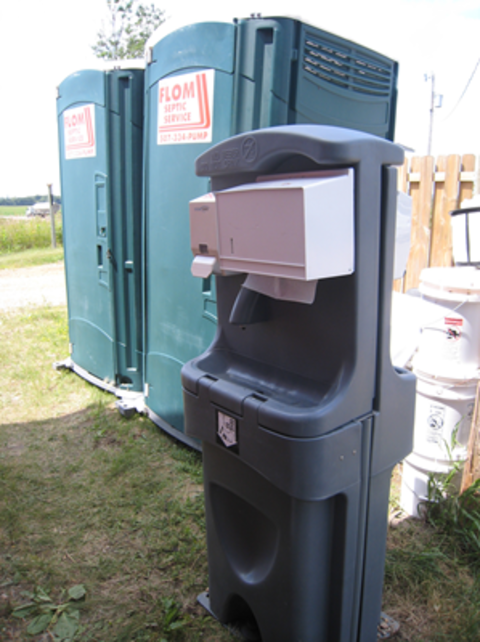Quick facts
-
Clean and accessible toilet facilities must be available on the farm site for all workers and visitors to use.
-
Proper field sanitation helps reduce the potential for contaminating produce and helps protect workers and consumers from foodborne diseases.
-
Teach all workers the importance of using toilet facilities and how doing so can reduce the potential for contaminating fields, produce, other workers and water supplies.
Location and number of toilets
Toilet facilities should be within one-quarter mile of all workers, including those working in the fields. If there are no portable toilet facilities near the growing fields, workers should have access to transportation to travel to the toilets. Driving to a gas station or other non-farm location to use a public restroom is not acceptable because cleanliness of those facilities is often variable.
Field toilets should be separated from the growing fields by a barrier such as a field road, ditch, berm, non-produce vegetation such as a hedgerow or shelter belt, or distant enough so accidental spillage or flooding will not contaminate production areas. There must be at least one toilet facility and one hand-washing facility for every 20 workers.*
Toilets should be accessible
Location, location, location. The easier it is to use the toilets, the greater the likelihood that they will be used. Workers should always have the opportunity to use the toilets when they need to, not only when they are on break. Having a toilet nearby reduces the likelihood of workers using inappropriate locations, such as the produce growing fields and surrounding areas.
Toilets should be properly sited
Toilet facilities in the field should placed in areas where they will not cause contamination to produce growing and handling areas from runoff in case of heavy rains or being accidentally knocked over.
They should not be placed near irrigation or wash water source areas. Runoff from improperly constructed or located toilets can contaminate soil, water sources, produce, animals and workers.
Toilets should be clean and well-supplied
Make sure that toilets are clean and well- stocked with toilet paper. Schedule regular cleaning times and adjust cleaning frequency as needed.
Hand washing units must be next to toilets
Workers should NOT have to enter or exit a building to wash their hands after using an outdoor toilet facility.
Hand washing stations should have potable water, a catch basin for used water, soap, enough hand towels for single use (paper or washable cloth) and a container for used hand towels.
Rental companies
Portable toilets can be rented for only a few hundred dollars per season. You can rent hand washing units too, and for an extra fee the company will clean and re-stock the toilet facilities and hand washing station on a regular schedule.
If you don’t want to rent a hand washing station, you can build your own.
*Growers should operate farms in accordance with the laws and regulations that describe field and facility sanitation practices. The field sanitation laws prescribed under the Occupational Safety and Health Act 29 CFR 1928.110, subpart I, describe the appropriate number of toilets to the number of workers, proper hand washing facilities, maximum worker-to-restroom distance, and how often such facilities should be cleaned.
Reviewed in 2018


